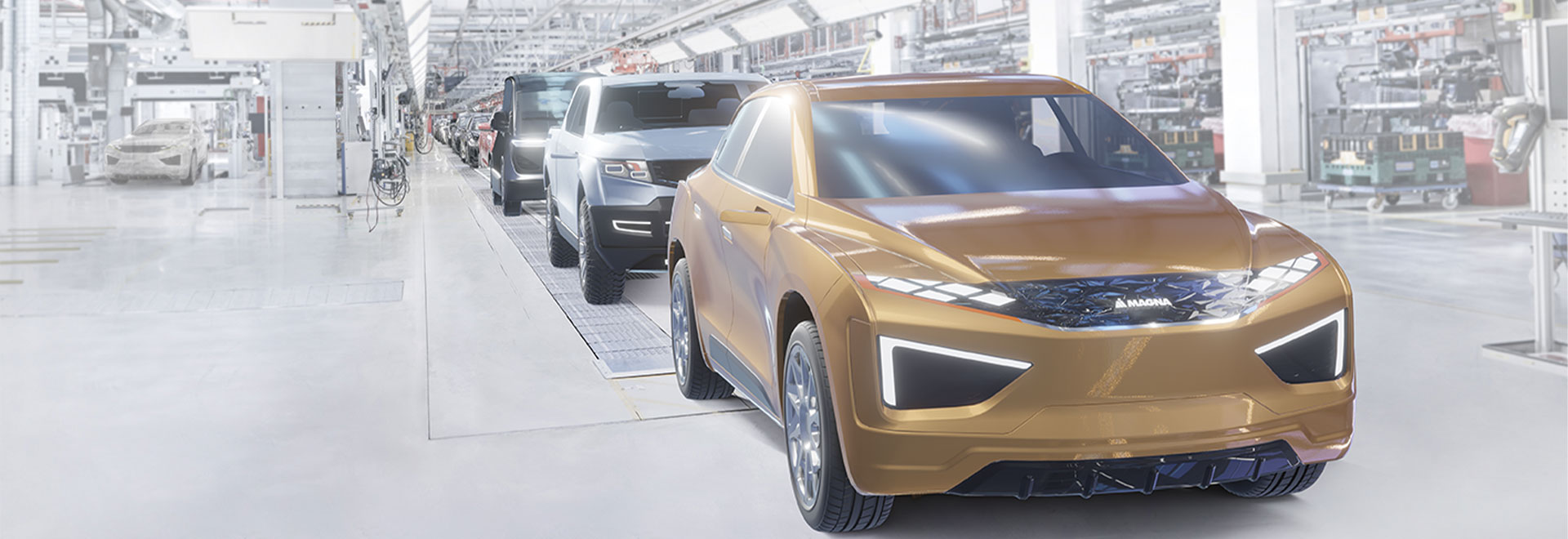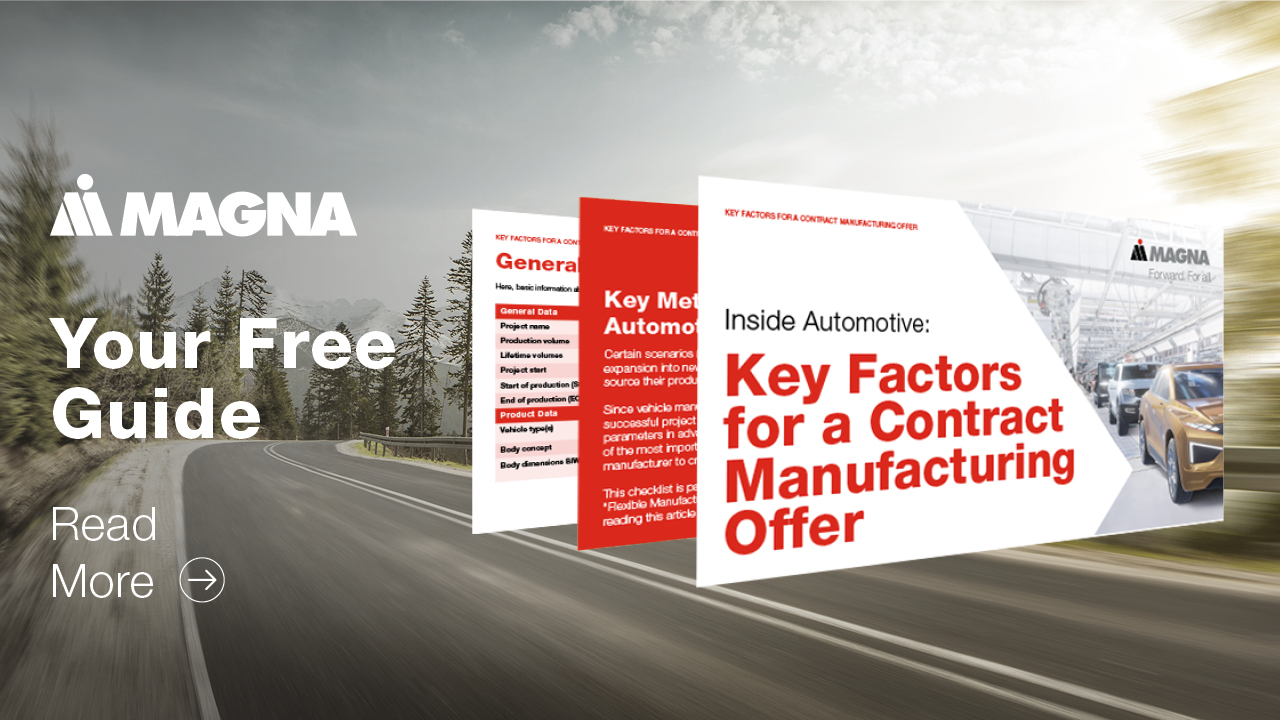
Flexible manufacturing in the automotive industry via multi-OEM contract manufacturing
- Erwin Fandl
- January 08, 2024
- 5-min read
Mobility is changing in different ways. Not only the products themselves are subject to change, as shown by the increasing market share of vehicles with alternative drive systems, but society's attitude towards mobility is shifting too, for example due to increasing awareness for sustainability. All of this is leading to a change in requirements and expectations among car buyers. The latest driving assistance and infotainment features are now competing strongly with classic vehicle attributes such as performance and handling. The automotive industry must therefore adapt its product range to meet the challenges of the future while also innovating production processes. Flexible manufacturing programs offered by experienced manufacturing partners can help to solve these challenges.
NECESSARY CHANGES IN AUTOMOTIVE MANUFACTURING
Many new entrants, particularly from Asia, are currently pushing into the European market with battery-electric cars, while established OEMs are also working under high pressure to transform their model range. Some may also have underestimated the speed of change, which has even increased due to the disruptions of recent years, from COVID-19 to the recent geopolitical events and the resulting supply bottlenecks.
THE TREND TOWARDS SMALLER PRODUCTION VOLUMES
Overall, the trends point towards lower production numbers per vehicle segment, which are also more difficult to predict. Given the many new market entrants, sales figures see shorter times of stability after the launch of a new vehicle because a new model becomes technologically obsolete more quickly. Volumes flatten out faster and the familiar seven-year model cycle is no longer the standard. In addition, the automotive market is becoming increasingly fragmented. On the one hand, more and more different body variants are being developed on a single platform to satisfy the customers' desire for individuality. On the other hand, more niche models and special series are also being developed and launched to counter the declining buyer interest after just a few years.
All these additional versions, with their usually rather small quantities, can disrupt the production process in the OEMs' plants, which are geared towards large series production. Niche models are difficult to integrate into an existing line, which is generally designed for higher production volumes of a certain model. In addition, it is often difficult to estimate whether the new vehicle will be well received by customers - or whether uncontrollable external influences will lead to an overall weakening of the market. Production must therefore be scalable, which is not always easy to achieve in the OEMs' main plants.
Many new entrants also start with relatively small quantities in the automotive market. For them, scalable, flexible manufacturing is particularly important to avoid having to build unnecessarily high capacities. However, they must still be able to meet unexpectedly high demand quickly.
THE ELECTRIFICATION MEGATREND - AND HOW TO BEST RESPOND TO IT
One of the most important global megatrends in the automotive industry is the current effort towards sustainability and CO2 reduction. As a result, market requirements are increasingly shifting from the traditional combustion engine to alternative drive systems and battery electric vehicles (BEVs).
Established OEMs are choosing different ways to tackle this challenge, though. The development of new, electrically powered vehicles is only the first step that most traditional manufacturers have already taken. The challenge now is to integrate the new electric vehicles into their existing production processes. Some OEMs are building completely new production lines for these models, while the combustion engine vehicles continue to run on existing production lines and continue serving this traditional market segment. This way, manufacturers keep earning money with conventionally powered vehicles and are therefore able to invest in the development and production of battery electric vehicles.
Other OEMs are converting existing plants so that only BEVs can be built and stop the production of combustion engine vehicles completely at these sites. This approach is not without risk, as purchasing behavior shows that the registration figures for electric cars appear to be more volatile and that the combustion engine is still in demand. Depending on the market segment and markets, the combustion engine vehicle is still the preferred mode of driving for many customers. Consequently, there is a trend toward developing universal platforms which can accommodate the vehicle architecture for both a conventional and an alternative drive system. However, this approach requires compromises, as the different drive types with their specific requirements call for different packaging. In addition, profound changes and adjustments to processes, production facilities and supply chains are necessary to ensure successful integration into the existing production and thus provide flexibility in manufacturing.
CONTRACT MANUFACTURERS AS PROBLEM SOLVERS
An external production partner with flexible manufacturing facilities can provide the OEM with a solution for the current challenges in the automotive industry. Due to their high degree of flexibility, contract manufacturers are also able to efficiently produce smaller quantities while still maintaining high quality. Magna, for example, has decades of experience in producing different vehicles on one line. Different programs with smaller quantities can utilize the capacity of a line and still be produced more economically. To a certain extent, it is also possible to balance the production capacity between different products to take full advantage of the production line, even if the expected number of units is not met.
For a multi-OEM manufacturer like Magna, the ability to achieve this constant balance is part of business success. Declining and fluctuating volumes can quickly lead to capacity underutilization for an OEM and make the production of models inefficient and cost intensive. The strategy of some OEMs to remove models with low margins from their portfolio also leads to lower utilization of plant capacities. It could therefore make sense for an OEM to outsource the phase-out production of a model that is still profitable, for example. Outsourcing production can also be just as viable if the OEM wants to test the acceptance of vehicle concepts or segments without having to allocate its production capacities.
FLEXIBLE MANUFACTURING AS IDEAL CONDITIONS FOR NEW ENTRANTS
Production with an external partner can be particularly rewarding for new players in the automotive industry. With a contract manufacturer, the new entrant has access to a production facility that is already set up for operation, including the workforce and comes with well-established processes and an existing supply chain. For larger projects, a manufacturing partner experienced in flexible automotive production also manages the complete industrialization: planning and setting up the factory, establishing the processes, setting up the infrastructure and defining suitable quality standards. As a result, new entrants not only face less risk in areas in which they have little experience but can also enter the market more quickly. Furthermore, they can focus on core tasks such as branding, advertising, the development of sales and service networks, and the acquisition of investors. This strategy eliminates some of the risk factors that repeatedly lead to the failure of start-ups in the automotive sector.
For many decades, Magna has been manufacturing several vehicle projects from various manufacturers with different requirements and quantities under one roof, as flexibility is the supplier's greatest strength. The workforce, infrastructure, and processes are already specialized in cross-OEM production. Depending on the degree of automation of the respective model series, the employees in production work in shorter or longer cycles with different workloads. Swift integration into customer systems and processes is also no challenge for the workforce. There is also a well-tried system of in-house processes and standards if Magna needs to work as independently as possible – which can help newcomers in particular to enter the market faster.
Multi-OEM projects with quantities ranging from 10,000 to over 100,000 vehicles per year have already been realized. With the production plant in Graz, Magna has also become the world's first contract manufacturer to produce a range of different propulsion technologies from different manufacturers on the same production line. Magna’s flexibility is also demonstrated in the paint shop, which successfully covers the most diverse requirements of a wide array of customers in a single facility.
Under the name "Flexible Manufacturing Solutions,” Magna has initiated an internal transformation to make production at the plant in Graz even more flexible and future-proof. Magna aims to produce up to four platforms and eight derivatives on one single line, regardless of drive type and quantity fluctuations. The company aims to be the fastest and most efficient partner in Europe for programs with medium (15,000 - 50,000 vehicles per year) and low production volumes (< 15,000 vehicles per year).
BODY CONSTRUCTION: MORE PLATFORM VARIANTS PER LINE
With a series of measures, flexibility in the body shop will continue to increase. By integrating flexible joining stations, several models can be produced on a single line without the need to set up a separate body shop for each model. A first step was the introduction of "Modular Flex Framing." In the future, this system will make it possible to frame up to six different body variants in a single station.
The centerpiece of this system is a flexible framer that holds up to three model-specific adapters in rotating storages, positioning them according to the next vehicle on the production line. For example, if a sedan enters the line, the corresponding adapters are automatically used to manufacture the sedan. If an SUV follows, the adapters change automatically to produce the SUV.
In addition, a geometry-forming "Modular Flex Geoskid" will enable the fully automated exchange of the geometry-forming devices. Instead of model-specific transport carriages, flexible and modular systems will be used. A universal frame is automatically fitted with specific adapters, enabling a quick changeover between different models. In sum, these measures will increase the number of body variants per line from two to five - or (if extended) even six.
INNOVATION IS KEY
It takes innovative solutions to ensure consistent product quality – for example the "Automated Body in White Fixture Control." The geometry-forming transport carriages are one of the most important elements in creating the geometry of the entire vehicle body. Geometric deviations in the carriages lead to deviations in the produced vehicle bodies, which can interfere with the further assembly process of the entire vehicle. To prevent this, the transport carriages must be checked periodically. However, they are usually not accessible during operation and must therefore be inspected off the production line.
Instead of this time-consuming periodic inspection, Magna now measures each vehicle body in a measuring station. A smart algorithm extrapolates from the measurement data whether the transport carriages are within fixed tolerances. This significantly more close-meshed inspection ensures that deviations are recognized and remedied instantly. Thus, rework on vehicle bodies that do not meet the tolerances can be greatly reduced.
FLEXIBLE MANUFACTURING OPTIONS IN THE PAINT SHOP
For years, Magna has already been coating all vehicles manufactured in Graz in a shared paint shop, regardless of manufacturer or exact platform. In this process, a high degree of customization is possible - from tailor-made paint designs to special paint effects (e.g. pearl shine effect, clear coat, matt coat), contrasting colors for roofs and doors to special colors. Low-temperature painting for things like special effect paintwork or the painting of attaching parts (like for special series) is also possible. In terms of a number of units, the paint shop can cover any volume from individual items (also known as lot size 1) to large-scale production, all in compliance with the quality standards of the respective automotive manufacturer.
OPTIMIZATION OF LOGISTICS THROUGH PROXIMITY TO THE ASSEMBLY LINE
At the Magna plant in Graz, logistics facilities are also moving closer to the assembly line to optimize the handling of the increasing variety of models and parts. Current industry-standard solutions are often not efficient enough and occupy too much space. The newly designed automated storage and retrieval system for sequencing provides employees with the vehicle parts right at the assembly line – in the right order and with the right equipment variants. This reduces both walking distances for logistics staff and the required space for sequencing. These measures make it possible for previously external sequencing volumes to now be sequenced close to the assembly line on the factory premises, which decreases transport requirements as well as cost per vehicle unit.
The optimized internal transportation processes also support sustainability efforts at the Graz site. The plant has already been carbon-neutral since 2022, and the improved logistics contribute to a further reduction of emissions.
INCREASED MEANS OF FLEXIBLE MANUFACTURING AT THE ASSEMBLY LINE
In the assembly, a flexible conveyor belt, a flexible marriage station, and extended test capacities allow the production of up to four instead of the previous two platforms on one assembly line. Interchangeable, product-specific adapters cover the differences in drive types, platform dimensions and body design. The increased load-bearing capacity of the conveyor belt further enables the production of larger and heavier vehicles in the future, already accounting for the increasing share of battery-electric vehicles in automotive production. The additional test rigs at the end of the production line ensure that the reliability of extended vehicle functions can be guaranteed.
By increasing flexibility in the various areas of manufacturing, Magna and its site in Graz continue to provide an ideal business partnership for both traditional and new car manufacturers. Customers in the automotive industry benefit not only from many years of experience in (flexible) manufacturing but also from shorter integration times.
Stay connected with Inside Automotive!

Erwin Fandl
Erwin Fandl has been Vice President Manufacturing at Magna Steyr since 2019. After joining Magna in 1992, he held several leading positions in Complete Vehicle Manufacturing and Quality Management. He holds a degree in technical engineering from the University of Graz.
We want to hear from you
Send us your questions, thoughts and inquiries or engage in the conversation on social media.
Related Stories

Market and Industry in Transition: How a Competent Partner Can Help Navigate Challenges in the Automotive Industry
Inside Automotive
.tmb-widescreen.webp?sfvrsn=8d57edff_1)
Successfully Starting Series Production: Start-up Management in the Automotive Industry
Inside Automotive

Strategy and Prototyping in UI/UX Development for Vehicle Control Concepts on Behalf of Customers
Inside Automotive

Professional Risk Management and Financing in Automotive Serial Production
Inside Automotive
Stay connected
You can stay connected with Magna News and Stories through email alerts sent to your inbox in real time.
